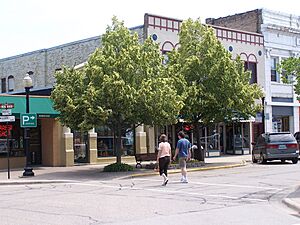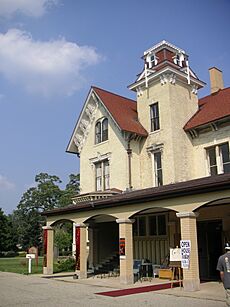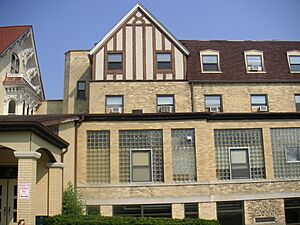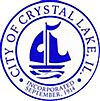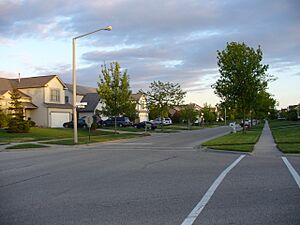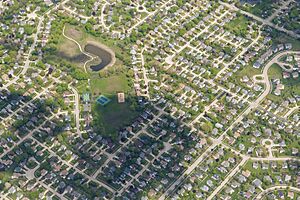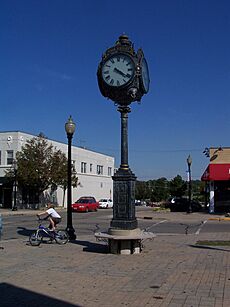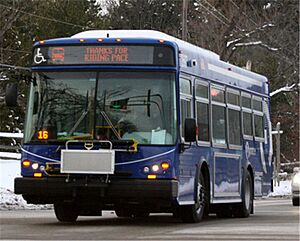Crystal Lake, Illinois facts for kids
Quick facts for kids
Crystal Lake, Illinois
|
|||
|---|---|---|---|

Downtown Crystal Lake
|
|||
|
|||
| Motto(s):
A Good Place To Live
|
|||

Location of Crystal Lake in McHenry County, Illinois
|
|||
| Country | |||
| State | |||
| County | |||
| Townships | Algonquin, Dorr, Nunda, Grafton | ||
| Adoption of city charter | September 23, 1914 | ||
| Government | |||
| • Type | Council-manager | ||
| Area | |||
| • Total | 19.53 sq mi (50.59 km2) | ||
| • Land | 18.92 sq mi (49.00 km2) | ||
| • Water | 0.61 sq mi (1.59 km2) | ||
| Elevation | 942 ft (287 m) | ||
| Population
(2020)
|
|||
| • Total | 40,269 | ||
| • Density | 2,128.61/sq mi (821.87/km2) | ||
| Time zone | UTC−6 (CST) | ||
| • Summer (DST) | UTC−5 (CDT) | ||
| ZIP Code(s) |
60012, 60014, 60039
|
||
| Area codes | 815/779 | ||
| FIPS code | 17-17887 | ||
| Home value: | $186,157 (2013) | ||
| Wikimedia Commons | Crystal Lake, Illinois | ||
Crystal Lake is a city in McHenry County, Illinois, USA. It's named after a beautiful lake southwest of its downtown. This city is about 45 miles (72 km) northwest of Chicago. In 2020, about 40,269 people lived here. Crystal Lake is the biggest city in McHenry County and is part of the larger Chicago metropolitan area.
Contents
History of Crystal Lake
How Was Crystal Lake Founded?
The city of Crystal Lake started from two early communities in the 1800s. These were known as Nunda and Crystal Lake. In 1835, Ziba S. Beardsley saw the lake and said its "waters were as clear as crystal." This gave the lake its name.
The first white settlers, Beman and Polly Crandall, arrived in February 1836. They came from New York in a covered wagon. Their first cabin was built near where Virginia Street and Van Buren Street are today.
The town was first called Crystal Ville. Its name changed to Crystal Lake before 1840. The area now known as downtown Crystal Lake was first called Dearborn. Later, it was named Nunda. This name came from a place in New York where many settlers were from.
The village of Dearborn began in the 1850s when railroads came through. The first train station was built in 1856. It was shipped from Chicago on a train car. The railroad connected both Crystal Lake and Dearborn to Chicago.
On October 7, 1868, Dearborn's name changed to Nunda. In 1874, both Crystal Lake and Nunda became official villages. In 1908, Nunda changed its name to North Crystal Lake. Finally, in 1914, North Crystal Lake joined with Crystal Lake. This created one city government.
The Dole Family and Their Mansion
In the 1860s, Charles S. Dole bought over 1,000 acres (400 hectares) of land. This land overlooked Crystal Lake. He wanted to build a fancy estate to show his success as a businessman. He was part of the Chicago Board of Trade.
He built a three-story mansion with gardens and stables. Workers from Europe laid special floors and carved wood. Italian artists built marble fireplaces. The mansion cost over $100,000, which was a huge amount back then.
The estate was called Lakeland Farm. Mr. Dole lived there with his family. He entertained many guests for over 30 years. For his daughter's wedding in 1883, he even built a special train track to his front door. Guests could walk from the train to the mansion on a covered, carpeted path. Important guests included Julian Rumsey, who was the mayor of Chicago.
Mr. Dole also built a half-mile racetrack on his property. He bought the best horses. He loved to watch his horses run from his tower. He later sold his horses. The Doles lived in the mansion until the late 1890s.
In the early 1900s, ice companies owned the property. They harvested ice from Crystal Lake and sent it to Chicago by train. When refrigerators became common, the ice business ended. The property was empty for several years.
In 1922, the Lake Development Company bought the property. In 1977, the First Congregational Church of Crystal Lake bought the building. They called it "Lakeside Center." It was used for community activities, a day care, and church offices. Today, the Dole Mansion is owned by Lakeside Legacy. There is a festival held there every year.
Eliza Ringling and the Country Club
Ringling Road is a street that curves from Country Club Road to Lake Avenue. It was named after Eliza "Lou" Ringling. She founded the Lake Development Company. In 1922, she bought the Dole Mansion. She turned it into the Crystal Lake Country Club. This was a very large real estate deal.
The original Crystal Lake Country Club faced problems during the stock market crash of 1929. Mrs. Ringling and her investors then divided much of the Dole estate. This became the Country Club Additions subdivision. Eliza "Lou" Ringling was the widow of Albert Ringling, one of the famous Ringling brothers from the circus.
Teco Pottery: Art from Clay
The American Terra Cotta Tile and Ceramic Company started in 1881. It was just north of Crystal Lake. Many workers lived in Crystal Lake. They made drain tiles, bricks, and architectural items.
In 1886, Gates Pottery was created as a part of this company. William D. Gates, a local man, was its president. This company made special glazed terra cotta. It was used on buildings designed by famous architects like Louis Sullivan and Frank Lloyd Wright.
Gates also experimented with clays to make art pottery. This led to the creation of Teco pottery in 1902. The name "Teco" comes from TErra COtta. Many pieces were designed by architects like Frank Lloyd Wright. This pottery was made for only a few years. Today, it is very popular with art collectors. Teco pottery is found in many museums.
Recent Times in Crystal Lake
On April 11, 1965, a strong tornado hit Crystal Lake. It damaged or destroyed many parts of the city. Six people died, and 75 were hurt. Damages cost over $1.5 million. About 80 homes and a shopping center were destroyed. Disaster shelters were set up for people who lost their homes.
Crystal Lake is also known for a special tradition. In 1982, people started anonymously giving gold coins to the Salvation Army here.
In the late 1900s and early 2000s, Crystal Lake grew a lot. More and more suburban neighborhoods were built. The population increased from 21,823 in 1990 to 38,000 in 2000. To handle this growth, Crystal Lake South High School opened in 1978. Prairie Ridge High School opened in 1997.
In 2015, WalletHub ranked Crystal Lake as the tenth best city. This was among 1,268 U.S. cities with populations between 25,000 and 100,000.
Aaron T. Shepley was the mayor of Crystal Lake from 1999 until his death in 2020. He was the longest-serving mayor in the city's history.
On July 7, 2021, U.S. President Joe Biden visited McHenry County College in Crystal Lake. He was the first sitting president to visit the city.
Geography of Crystal Lake
What Are Crystal Lake's Neighborhoods Like?
Crystal Lake is the largest city in McHenry County. It has three high schools and many different neighborhoods.
In the north, there's an area called "by Prairie Ridge." Houses here are large and spread out. This area is north of downtown, stretching towards Bull Valley. Some communities here include Deer Wood and Covered Bridge Trails.
Downtown Crystal Lake is next. It surrounds Crystal Lake Central High School. Houses here vary a lot in size and age. It's the most diverse neighborhood.
South of downtown is the Coventry neighborhood. It's named after Coventry Lane, a main street. Students here go to either Central or South High School. People say that pilots who flew out of O'Hare Airport first lived in Coventry. The Burtons Bridge neighborhood is on the northeast side of Crystal Lake.
Southwest of downtown is the large Four Colonies neighborhood. It covers almost 2.5 square miles (6.5 km2). Students from Four Colonies attend both Central and South High School.
South of Four Colonies is The Villages neighborhood. It's named after Village Road. Indian Prairie Elementary School is in The Villages. It's built on hills that are popular for sledding in winter. Residents here attend South High School.
Northeast of Four Colonies is Wedgewood. This neighborhood has five ponds and a forest. It also has a paved walking path. Wedgewood has single-family homes and townhouses. Wedgewood Drive circles the whole neighborhood.
Other neighborhoods are around the city's lake. These include West End, North Shore, and the Vista. These areas have many older homes built on the lake shore. The independent Village of Lakewood is on the south shore of the lake. It's historically linked to the Crystal Lake Country Club.
What is the Climate Like in Crystal Lake?
Crystal Lake's climate is similar to Chicago's. Summers are hot, and winters are cold. Temperatures can be a bit more extreme than in closer suburbs. This is because rural land still surrounds the city.
July is the hottest month. The average high temperature is about 86°F (30°C). Summer temperatures can often go above 95°F (35°C). January is the coldest month. The average high is 23°F (-5°C). Overnight lows are usually around 8°F (-13°C). Winter nights can drop below 0°F (-18°C) often.
August is the wettest month, with heavy rain from thunderstorms. July is also wet due to thunderstorms. January and February are the driest months. Most of the rain then falls as snow. A typical year gets about 37 inches (940 mm) of rain. Winter snowfall is about 40 inches (1,000 mm). Large snowstorms can happen, bringing over 12 inches (300 mm) of snow in one day.
| Climate data for Crystal Lake, Illinois, 1981–2010 normals, extremes 1849–present | |||||||||||||
|---|---|---|---|---|---|---|---|---|---|---|---|---|---|
| Month | Jan | Feb | Mar | Apr | May | Jun | Jul | Aug | Sep | Oct | Nov | Dec | Year |
| Record high °F (°C) | 62 (17) |
70 (21) |
82 (28) |
91 (33) |
92 (33) |
101 (38) |
101 (38) |
98 (37) |
95 (35) |
89 (32) |
75 (24) |
67 (19) |
101 (38) |
| Mean daily maximum °F (°C) | 28 (−2) |
33 (1) |
44 (7) |
58 (14) |
69 (21) |
79 (26) |
83 (28) |
81 (27) |
74 (23) |
62 (17) |
46 (8) |
33 (1) |
58 (14) |
| Daily mean °F (°C) | 20 (−7) |
25 (−4) |
35 (2) |
47 (8) |
58 (14) |
68 (20) |
73 (23) |
71 (22) |
63 (17) |
51 (11) |
38 (3) |
25 (−4) |
48 (9) |
| Mean daily minimum °F (°C) | 11 (−12) |
16 (−9) |
26 (−3) |
36 (2) |
47 (8) |
57 (14) |
62 (17) |
60 (16) |
51 (11) |
40 (4) |
29 (−2) |
17 (−8) |
38 (3) |
| Record low °F (°C) | −27 (−33) |
−22 (−30) |
−8 (−22) |
11 (−12) |
28 (−2) |
36 (2) |
45 (7) |
40 (4) |
29 (−2) |
18 (−8) |
−7 (−22) |
−24 (−31) |
−27 (−33) |
| Average rainfall inches (mm) | 1.68 (43) |
1.38 (35) |
2.23 (57) |
3.91 (99) |
3.84 (98) |
4.31 (109) |
3.93 (100) |
4.43 (113) |
3.63 (92) |
2.66 (68) |
3.12 (79) |
2.1 (53) |
37.22 (945) |
| Average snowfall inches (cm) | 10.2 (26) |
7.3 (19) |
4.5 (11) |
1.1 (2.8) |
— | 0.0 (0.0) |
0.0 (0.0) |
0.0 (0.0) |
0.0 (0.0) |
0.1 (0.25) |
1.5 (3.8) |
9.8 (25) |
34.5 (88) |
| Source 1: http://www.intellicast.com/Local/History.aspx?location=USIL0280 | |||||||||||||
| Source 2: https://w2.weather.gov/climate/xmacis.php?wfo=lot | |||||||||||||
People of Crystal Lake
| Historical population | |||
|---|---|---|---|
| Census | Pop. | %± | |
| 1880 | 546 | — | |
| 1890 | 781 | 43.0% | |
| 1900 | 950 | 21.6% | |
| 1910 | 1,242 | 30.7% | |
| 1920 | 2,249 | 81.1% | |
| 1930 | 3,732 | 65.9% | |
| 1940 | 3,917 | 5.0% | |
| 1950 | 4,832 | 23.4% | |
| 1960 | 8,314 | 72.1% | |
| 1970 | 14,541 | 74.9% | |
| 1980 | 18,590 | 27.8% | |
| 1990 | 24,512 | 31.9% | |
| 2000 | 38,000 | 55.0% | |
| 2010 | 40,743 | 7.2% | |
| 2020 | 40,269 | −1.2% | |
| U.S. Decennial Census 2010 2020 |
|||
What is Crystal Lake's Population Like?
In 2020, Crystal Lake had 40,269 people. There were 14,780 households and 10,551 families. About 31.9% of homes were in buildings with multiple units.
The city's population was 79.8% White (76.92% non-Hispanic White). About 1.5% were Black or African American. Around 0.4% were Native American, and 2.8% were Asian. Less than 0.01% were Pacific Islander. About 6.1% were from other races, and 9.3% were from two or more races. People of Hispanic or Latino background made up 14.8% of the population.
About 35.4% of households had children under 18. Most households (51.0%) were married couples.
The population was spread out. About 24.0% were under 18 years old. About 13.5% were 65 years or older. The average age was 39.6 years. For every 100 females, there were 97.9 males.
The average income for a household was $87,578. For a family, it was $105,324. About 6.9% of the population lived below the poverty line. This included 9.9% of those under 18.
Arts and Culture in Crystal Lake
Crystal Lake is big enough to have its own cultural places. It also shares many cultural chances with Chicago. The city has the Northwest Herald, a daily newspaper for McHenry County. Churches are also important, hosting many yearly events. Crystal Lake is home to WZSR Star 105.5, a radio station.
The Crystal Lake Park District runs over 40 parks and recreation areas. Two main parks are Veterans Acres and Lippold Park. Crystal Lake itself is open when the weather is good. The Crystal Lake Rowing Club uses the lake for rowing.
The historic downtown district is a popular spot. It has many small shops and businesses. The Raue Center for the Arts is also downtown. It's a theater that hosts plays and concerts. It has become a regional destination. The city also has the Crystal Lake Strikers Drumline and the Crystal Lake Community Band.
The Col. Gustavus A. Palmer House is a historic home in Crystal Lake. It was built in 1858.
Economy of Crystal Lake
Crystal Lake's economy doesn't rely on one main industry. There are several large companies, but none employ most people. The main activities are shopping, dining, and light industry. This includes small local shops and restaurants, as well as national chains.
There are several industrial parks in Crystal Lake. These have small, local businesses. They do things like landscaping or car repair.
Most shopping happens on "the strip." This is a long road on Route 14. It has many national chain stores. The downtown district also has smaller, independent stores.
The south side of the city has several gravel quarries. Many of these are no longer used. They have filled with water, forming the Vulcan Lakes. These lakes also stretch into Lake in the Hills, Illinois and Algonquin, Illinois. The two northernmost lakes are now called Three Oaks Recreation Area. This area opened in 2010 and is very popular.
Parks and Recreation in Crystal Lake
The Crystal Lake Park District manages over 40 parks and recreation areas. This is a separate group from the city government. Important parks include the 140-acre Veteran Acres Park. Lippold Park is the largest park at 305 acres.
Education in Crystal Lake
Crystal Lake's high schools are part of Community High School District 155. Crystal Lake Community Consolidated School District 47 runs all middle and elementary schools in the city.
There are five high schools that serve Crystal Lake. The oldest is Crystal Lake Central High School, which opened in 1924. Crystal Lake South High School opened in 1978 due to population growth. Prairie Ridge High School opened in 1997. Small parts of Crystal Lake are also served by Cary-Grove High School and Woodstock High School.
Other schools in Crystal Lake include:
- Lord and Savior Lutheran School (Pre-K-8)
- St. Thomas the Apostle (private Roman Catholic school, Pre-K-8)
- Immanuel Lutheran School (private Lutheran school, Pre-K-8)
- Faith Lutheran High School (serves the wider McHenry County area)
There are also two colleges in Crystal Lake:
- McHenry County College, a community college
- Columbia College has a campus here.
Transportation in Crystal Lake
Crystal Lake is about 45 miles (72 km) northwest of Chicago. It's about a 45-minute drive from O'Hare International Airport. Major highways nearby include U.S. Route 14, Illinois Route 176, and Illinois Route 31.
The Metra Union Pacific Northwest Line provides train service to and from Chicago. Trains stop at the Crystal Lake and Pingree Road stations. The Pace Bus system also serves Crystal Lake.
Taxi services in Crystal Lake include Crystal Lake Cab Company and Crystal Lake Taxi Services.
Sister Cities
- Holzgerlingen, Germany (since 1996)
Notable People
See also
 In Spanish: Crystal Lake (Illinois) para niños
In Spanish: Crystal Lake (Illinois) para niños




